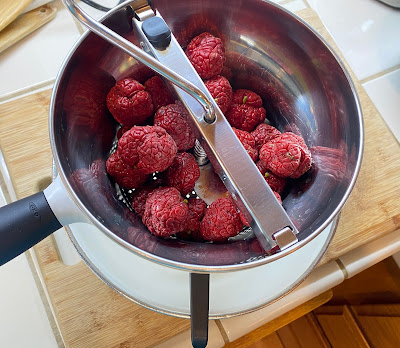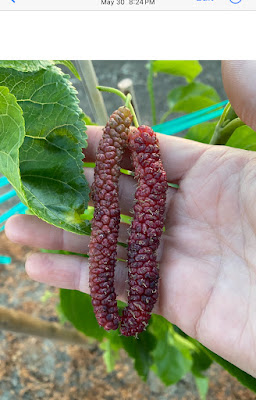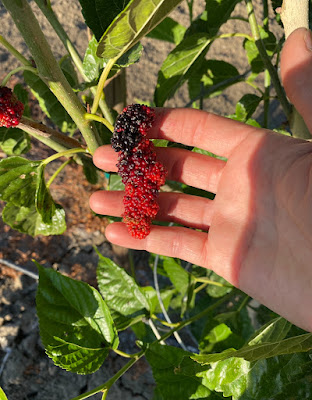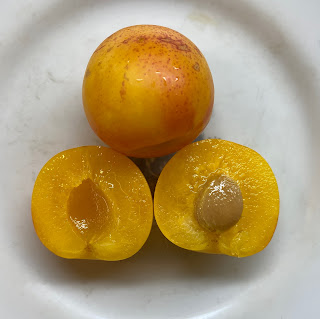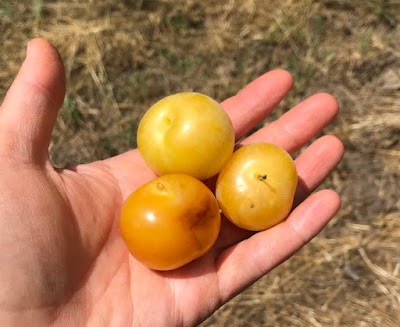This post describes a pretty uncommon, but a wonderful and an easy-to-grow fruit. The Che fruit (Cudrania tricuspidata, Maclura tricuspidata) originates from China, but not even every Chinese will know it. However, the various parts of this tree are used for centuries in the traditional Eastern medicine. This paper summarizes the traditional uses, the chemical compounds isolated from this tree and their pharmacological activities.
Majority of people who tasted this fruit, never seen a selection producing the fruits as large as the cultivar Oregon Exotics. This particular accession was introduced by Jerome Black many years ago and was originally distributed through his (now defunct) nursery Oregon Exotics. The fruits are wonderfully sweet berry ripening in November. I started growing this accession about 7-8 years ago, and had my first harvest in 2018. The first time I described these fruits in this post in November of 2020.
My new Che trees in the new orchard turned out to be great producers just after one year in the ground. I have not weighed the harvest of 2023, but my estimate is that we picked close to 20 pounds from two small female trees. These are surrounded by two male trees and I suspect that pollinated fruits hold better and definitely grow larger.
The leaves on the male trees look abnormally rolled in, and this seems to be typical for this male accession.
The male trees grow more vigorously and taller than the female trees. I posted a video on how different the foliage looks like on male vs female trees:
https://youtube.com/shorts/C5_TvOxZ5ZA?si=rw3KBuHbN95yIm4X
The birds started damaging the fruits in early October, and by October 15 we put the tulle net over the trees to save the harvest. These berries need to be fully ripe before harvesting, and the netting allowed us to harvest the ripe undamaged fruits. Below is the link to a video from mid October with the netting structure.
https://youtube.com/shorts/tetVJQXG7EA?si=ED49_QUX7vbjT8Yf
Here in the Sacramento Valley, the fruit are getting ready in November. This year I harvested most of the fruits on November 17 and November 18, and the very last batch was harvested on November 25. In the picture below are the Che fruits along with the very last figs from November 25.
The link below points to my last Che tasting video taken in the orchard on November 18:
These fruits are highly perishable and should be used or processed the same day they were harvested. They are very sweet with chocolaty-watermelon flavors. Besides consuming them fresh as we would do any other berry, we also juiced them. The juice can be stored for a few days in the fridge.
For juicing I used a simple food processor which I also use for pomegranate arils and cut tomatoes. The solids and seeds stay in the crushing bowl, and the juices drain to the large bowl placed under the processor, see the pictures below.
The video link to the YouTube Short showing the process:
We ended up with a lot of juice and pulp.
The juice is viscous and can be stored for a few days in the fridge. It’s actually best when consumed cold. Sometimes I add a little of lime juice to Che juice and it becomes a bit brighter. Otherwise the flavor of Che is intensely sweet with the chocolate and watermelon notes in it. I like the Che juice without lime better, but my family prefers it with some lime juice. Just use very small amount of lime juice if you want to experiment with it. No more than a teaspoon of lime juice per cup of Che juice.
I also processed the solids after juicing into the fruit leather. I spread the solids on the wax paper and dried in the oven for 2-3 hours at 170F. Then I left it overnight in the oven, and dried it again the same way. Then, I finished the drying outside of the oven for a day.



The dried leather is mildly sweet and crunchy. I experimented with adding various flavoring into it, like vanilla extract, lime juice, and cocoa powder. I liked the lime and cocoa in the dried leather.
I have also froze some amount of fruit in Ziplock bags and planning to juice them later.
Concluding remarks
I think the main reason why this fruit stays relatively unknown even for the active gardeners is the lack of the easily available rootstocks. Che trees are generally grafted onto the Osage orange seedlings. These are occasionally available from
Fruitwood Nursery. Otherwise you would need to grow them yourself using the seeds from the large green balls falling from the Osage Orange trees in fall. These are commonly planted across California, and can often be found along the county roads.
Last summer I also found out that Osage Orange roots relatively easily from the green cuttings. We made a number of rootstocks this way, I planted them in the orchard in fall, and they will be grafted in the spring. This might be a faster way to the production of Che rootstocks. They become graft-able in under one year. It will be interesting to check if the dormant wood of Osage orange roots too, and I'm planning to test it this winter.
Normally, you don't want to use Che seedlings as rootstocks as they tent to sprout a lot of suckers. Some people were able to root the Che cuttings too, but the process may not be that efficient, and you will end with many suckers, I heard.
We don't have any extra rootstocks available, but we still have plenty of Oregon Exotics Che scions at
reallygoodplants.com and plan to have them every year during our winter and spring sales.






